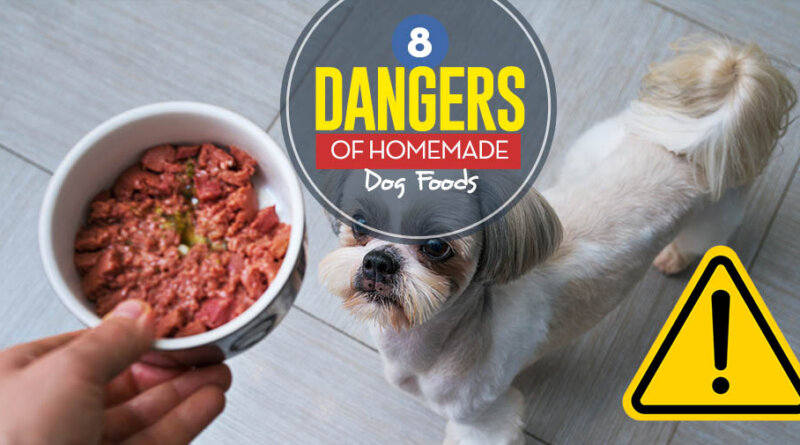8 Dangers of DIY Homemade Dog Food (and how to avoid all of them)
Feeding your dog a DIY homemade dog food is something that more and more dog owners are doing these days. It’s understandable as many of us are becoming aware of the shady manufacturing practices in the pet food industry, filler ingredients, fake “Made in USA” labels and other things harmful to our pets. Using homemade dog food recipes is a way to let your pooch enjoy the finer things in life, in particular high-quality and delicious meat.
However, homemade dog food isn’t risk-free either. A 2013 study by the Journal of the American Veterinary Association from a while back showed that more than 90% of homemade dog food recipes found online may be bad for your dog. The study went over 200 recipes from reputable veterinary textbooks and certified veterinary nutritionists, as well as other pet-related sources, and of the 200 recipes, 191 weren’t up to par with the Association’s standards. That’s ~96%!
Another more recent 2017 study evaluated more DIY homemade dog food recipes found online and gave them to pet owners to test. After the analysis, the scientists concluded that these diets exposed pets to nutrient deficiencies.
DIY homemade dog food diet isn’t that simple…

Pet owners are not aware of what type of nutrients are being left out from the meal, they rarely use essential dog supplements such as fish oil or monitor the dog for nutrient deficiencies to make up for any vitamins, minerals and macro-nutrients.
To further illustrate this, a 2014 study by the Clinical Nutrition Service, Teaching Veterinary Hospital of the College of Agrarian and Veterinarian Sciences, São Paulo State University, used adequate dog food recipes with 59 dog owners and evaluated the way pet owners prepared the DIY homemade dog food meals.
The study found that even though the recipes were good and the vets had instructed dog owners properly on how to prepare it, the owners didn’t follow the instructions well enough to make a healthy meal for their dog.
- 30.4% of the people admitted to purposely changing the recipe.
- 40% of owners didn’t measure the proportions of the ingredients well enough.
- 73.9% didn’t use the right amount of soybean oil and salt.
- 28.3% didn’t use any of the recommended vitamins, minerals, or amino acid supplements that they were instructed to add into the recipes.
The above study begs the question: even if the DIY homemade dog food diet has the potential to be much healthier for our dogs than commercial dog food brands, is it worth the risk if you’re not sure whether you can follow all the necessary instructions to a letter?
To help you make up your mind about cooking for your pooch – or at least to better prepare the meals for your pets – here’s a list of 8 potential dangers of DIY homemade dog food and how you can avoid them while still making home-prepared meals.
ALSO READ: 20 Pros and Cons of Homemade Dog Foods
1. Bad Ingredients

Surprisingly, there’s a number of homemade dog food recipes found online that consist of things that no dog should consume (or consume very little, yet the recipe mentions dangerous amounts). Some of the more extreme examples include giving your dog large amounts of garlic as a way to prevent intestinal worms or feeding your pup avocado, “because it’s healthy for people”.
The root to such mistakes is usually in the fact that owners assume dogs can eat almost everything we can, and it may be healthy for them. And while it’s true that dogs are omnivores, have stronger stomachs than us (in some ways) and some human foods are extremely good for them, there’s a number of food items you should be careful about when preparing your dog’s next dinner.
2. Missing Ingredients
You may be using a dog food recipe that’s missing some key ingredients.
The opposite problem with DIY homemade dog food recipes is also very common – forgetting to include essential ingredients in your dog’s meal. I’ve mentioned some of these above – skipping on the vitamins, minerals, and amino acid supplements is often overlooked by pet owners. Samantha has previously explained which supplements may be required for homemade dog food meals, and how to use them safely.
Also, avoiding any organ meat (like liver or heart) in DIY homemade dog food meals because it looks inedible to us is another big mistake. If this happens every once in a while, that won’t be a problem, so don’t throw away the most recent batch you’ve just made simply because you forgot a piece of liver. However, doing this systemically can lead to a lot of deficiencies and health issues for your dog, according to studies.
3. Nobody’s Watching

“Quality control” doesn’t have a nice ring to it – anyone involved in the manufacturing of pet foods, pet medicine or other pet products that require quality control and monitoring by agencies like FDA and USDA do not want to hear about it, because it increases costs. This is why companies that make human-grade dog food and have frequent factory inspections (like The Honest Kitchen) have to raise costs for their pet food products.
However, quality control is essential to ensure well-balanced food, and when you’re making your own DIY homemade dog food meals, it’s often a noticeable absence. Most of the mistakes people made with home-made recipes in the 2014 Clinical Nutrition Service study were unintentional and were precisely due to the lack of quality control.
4. Inappropriate Substitutions
You may be tempted to substitute some ingredients.
While some of the mistakes dog owners make when prepare pets’ meals are completely unintentional, many others are actually made on purpose, as the above studies demonstrated. This is likely out of ignorance. Even though there’s a large number of homemade dog food recipes available with different ingredients, substitutions occur.
For example, substituting one ingredient with another may seem innocent enough when the two ingredients are similar in our eyes, but for a dog’s body this may not be so. When you get a dog food recipe from a reputable source (and you double check with at least 2-3 other reputable sources), it’s important that you follow the recipe to the letter. If you need to substitute, make sure you research or better yet, consult with a canine nutritionist.
5. Lack of Storage
You may face problems with storing your homemade dog food meals.
When preparing DIY homemade dog food, it’s likely you’ll be making large quantities of it. After all, you don’t want to cook it every day. However, with the larger quantities come some potential storage problems. And not storing your pet’s food properly in a special dog food storage container or fridge, not freezing when needed, is about as dangerous as not storing your own food in an adequate way.
6. Inevitable Changes
With time you may unwillingly change the recipe.
Another way your DIY homemade dog food approach can change is simply with the passage of time. Even if you aren’t changing any ingredients and even if you’ve made your pet’s meal expertly at first, as the days, months and years pass by, it’s very likely that you’ll unintentionally change the way you prepare the meals.
Some pet owners admit that they often start making it faster, and they are preparing the ingredients more automatically. If one day you go back to the original recipe, chances are that you’ll notice some differences from what you’re currently doing.
7. Bad Purchases

The quality of meat you’re using is essential for the long-term health of your dog. Yes, very cheap commercial dog food is rarely made out of high-quality ingredients either, but that’s nevertheless a problem that you too must be wary of when you’re cooking your own dog’s dinner. It’s time consuming to be picky about the ingredients you’ll use in your Fido’s meal, but something that cannot be avoided.
8. No Way Back
Pets that love homemade dog food may start disliking commercial dog food.
A less dangerous but a potentially annoying problem for pet owners is the risk of getting a dog used to DIY homemade dog food meals, and becoming completely unfamiliar with commercial dry kibble. Most dogs are ravenous, but some breeds in particular can be picky eaters.
When your pooch refuses to eat commercial dog food, be it dry or canned, then sooner or later you might be faced with a problem: you won’t have any prepared DIY homemade dog food meals on hand (due to lack of time or whatnot) at home and your canine may be refusing to eat anything else. Fortunately, this is relatively easy to avoid by feeding your dog some commercial dog food from time to time from an early age.
READ NEXT: 13 Balanced Homemade Dog Food Recipes
Pin and share with other dog owners:






